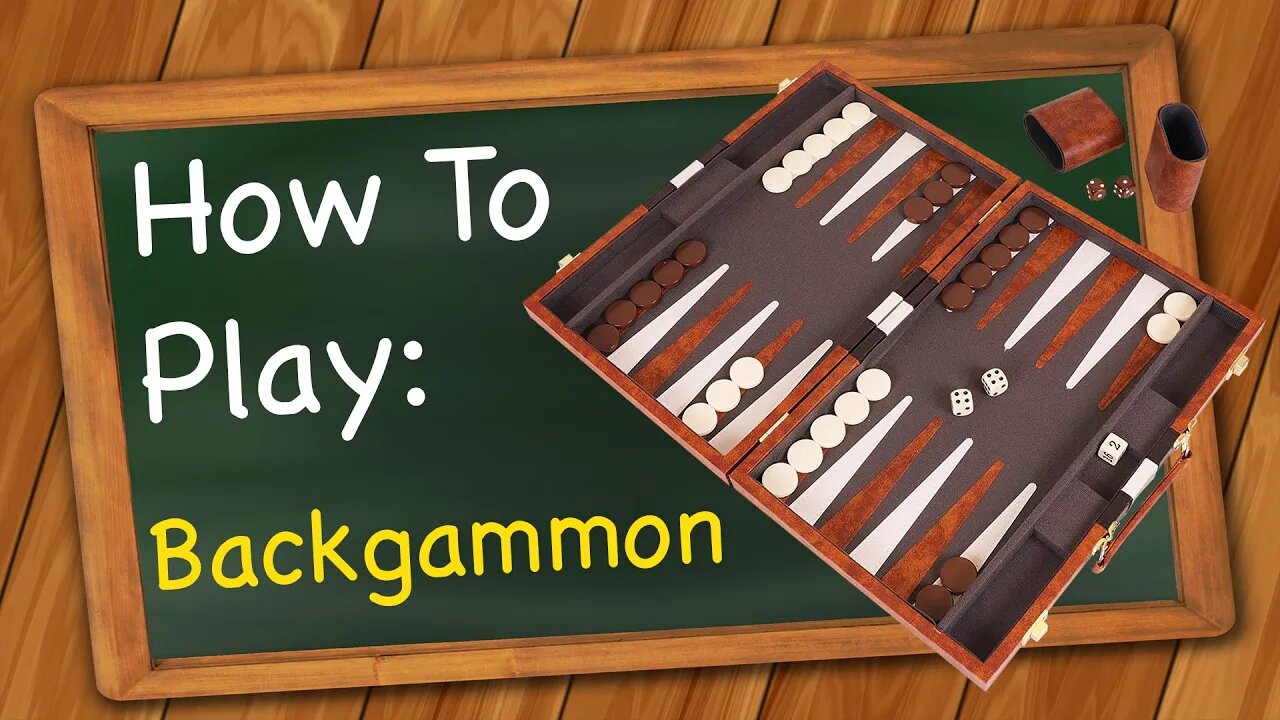Premium Only Content

How to Play Backgammon
Learn the rules to the board game Backgammon quickly and concisely - This visually rich video has no distractions, just the rules.
Don't own the game? Buy it here:
USA - https://amzn.to/3j5b8cg
Canada - https://amzn.to/2VwWR1p
UK - https://amzn.to/38XFTfE
Australia - https://amzn.to/3tG3tY8
(These Amazon Affiliate links directly supports me)
RULES: https://gamerules.com/rules/backgammon-board-game/
Each player rolls one die. The player with the highest die goes first but uses the results of both dice rolled on their first turn. If it is a die then both players reroll. When rolling dice you must roll both dice together in your cup onto your right-hand section of the board. If any dice go outside of your board, land on a checker, or doesn’t land flat, the roll is invalid and you must reroll both dice.
A turn is completed when the player picks up his dice. If the play is incomplete or otherwise illegal, the opponent has the option of accepting the play as made or requiring the player to make a legal play. A play is deemed to have been accepted as made when the opponent rolls his dice or offers a double to start his own turn.
If a player rolls before his opponent has picked up the dice to complete his turn, the player's roll is voided. This rule is generally waived any time a play is forced, like when your opponent is unable to play.
The dice indicate how many points you can move a checker. Checkers always move around the board in the direction from your opponent’s home base, to their outer board, to your outer board, then into your home base. A checker may only be moved to an empty point, a point you already have checkers in, or a point that is occupied by exactly one opponent checker.
You may move the same checker more than once a turn. A player who rolls doubles plays the numbers shown on the dice twice, for a total of 4 moves. The player may move any combination of checkers he feels appropriate to complete this requirement.
A player must use both numbers of a roll if this is legally possible, or all four numbers of a double. When only one number can be played, the player must play that number. If either number can be played but not both, the player must play the larger one. When neither number can be used, the player loses his turn. In the case of doubles, when all four numbers cannot be played, the player must play as many numbers as he can.
A point occupied by a single checker of either color is called a blot. If an opposing checker lands on a blot, the blot is removed and placed on the middle-raised area of the board, called: the bar.
Any time a player has one or more checkers on the bar, his first obligation is to enter those checkers into the opposing home board. A checker is entered by moving it to an open point corresponding to one of the numbers on the rolled dice. 1 being the 24 point and 6 being the 19 point.
If neither of the points are open, the player loses his turn. If a player can enter some, but not all of his checkers, he must enter as many as he can and then forfeit the remainder of his turn. After all the player’s checkers on the bar have been entered, any unused numbers on the dice must be played, by moving either the checker that was entered or a different checker.
Once a player has moved all fifteen of his checkers into his home board, he may begin bearing them off. A player bears off a checker by rolling a number that corresponds to the point on which the checker resides, and then removing that checker from the board. Thus, rolling a 3 permits the player to remove a checker from the 3 point. A player is under no obligation to bear off if he can make an otherwise legal move.
If there is no checker on the point indicated by the roll, the player must make a legal move using a checker on a higher-numbered point. If there are no checkers on higher-numbered points, the player is required to bear off a checker from the highest point on which one of his checkers resides. For example, if you roll a three, you cannot bear off a 1 point checker unless that is the only point where checkers remain.
A player must have all his checkers in play in his home board in order to bear off. If a checker is hit during the bear-off process, the player must bring that checker back to his home board before continuing to bear off. The first player to bear off all fifteen checkers wins the game.
Backgammon is played for an agreed stake per point. Each game, the stakes start at one point. During the game, a player may propose doubling the stakes. He may do this only at the start of his own turn before he has rolled the dice.
A player who is offered a double may refuse, in which case he concedes the game and pays one point. Otherwise, he must accept the double and play on for the new higher stakes. A player who accepts a double becomes the owner of the cube and only he may make the next double....
-
 2:21
2:21
Triple S Games
2 years ago $0.06 earnedHow to play Cruise Pawns
1.01K -
 1:27:59
1:27:59
vivafrei
4 hours agoDid the Capitol Police KNOW About the Jan. 6 Pipe Bombs IN ADVANCE? Live with Journalist Julie Kelly
59.7K61 -
 1:41:10
1:41:10
The Quartering
3 hours agoEpstein Files Release IN DOUBT, Muslims Vs Christians In Dearborn, Republicans FAIL To Censure
125K34 -
 1:24:12
1:24:12
DeVory Darkins
5 hours agoDISTURBING: Congress pulls insane stunt after failing to censure Rep Plaskett
121K89 -

The HotSeat With Todd Spears
2 hours agoEP 212: What Happened In 610 AD??
14.9K16 -
 10:58
10:58
China Uncensored
3 hours agoJapan Wants Nukes
15.5K19 -
 2:10:27
2:10:27
Side Scrollers Podcast
6 hours agoEpstein Files Release INCOMING + GTA6 Dev PROTEST + International Men’s Day + More | Side Scrollers
94.2K13 -
 3:23:39
3:23:39
Right Side Broadcasting Network
8 hours agoLIVE REPLAY: President Trump Delivers Remarks at the U.S. - Saudi Investment Forum - 11/19/25
78.9K16 -
 2:08:00
2:08:00
The Charlie Kirk Show
5 hours agoIslam vs. America + The Future of Florida + Chaper Leaders Report | Enjeti, Rep. Donalds | 11.19.25
94.7K26 -
 12:32
12:32
Dr. Nick Zyrowski
16 days agoProbiotic Benefits - INCREDIBLE Ways Probiotics Will Transform Your Health
38K1